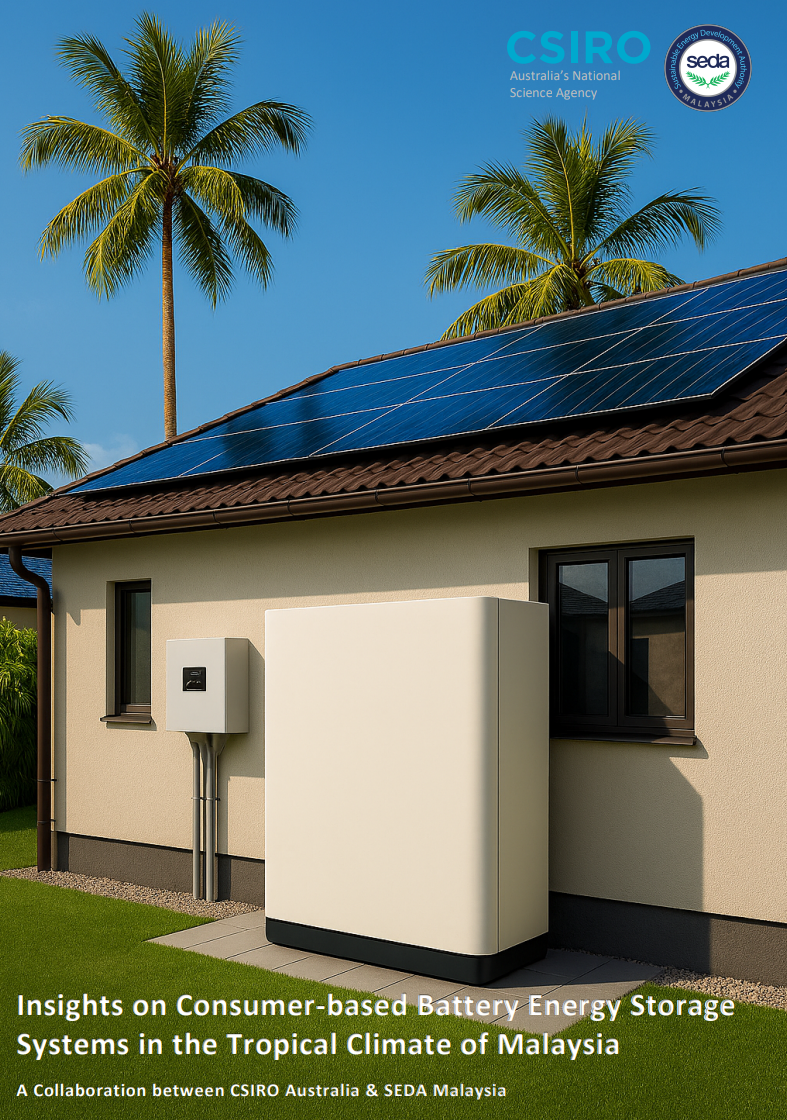Tropical batteries report
The SEDA–CSIRO Tropical Batteries Report 2025 is a landmark collaboration between Australia's national science agency, CSIRO and Malaysia's Sustainable Energy Development Authority (SEDA).

This report underscores Malaysia's position as one of the leading countries in ASEAN's energy transition, showing how consumer-based battery energy storage systems (BESS) can support its renewable energy and emissions reduction targets.
With Malaysia aiming for 70% renewable energy by 2050, reliable, safe, and cost-effective energy storage is essential to overcome the challenges of solar intermittency, grid stability, and peak demand mismatches.
A deep dive into battery technologies for the tropics
The report explores six major battery families, including lithium-ion, sodium-ion, lead-acid, nickel-based, redox-flow and molten salt batteries.
It evaluates their technical performance, commercial viability and sustainability in Malaysia's tropical climate. It highlights how high temperatures, humidity and salinity present unique challenges for battery durability and efficiency, and discusses strategies to mitigate these effects, all of which are also particularly relevant for the northern regions of Australia.
The analysis covers everything from residential and community-scale storage to large commercial and industrial applications, offering a clear framework for decision-makers and stakeholders.
Sustainability and innovation for a greener tomorrow
Beyond technical details, the report addresses the environmental impacts and end-of-life management of batteries, emphasizing the importance of recycling and reuse as the world's energy landscape evolves. Drawing on global case studies and best practices from Australia, the US, and Europe, it outlines policy, regulatory, and infrastructure strategies to accelerate the adoption of battery energy storage, and support a resilient and low-carbon future.
Empowering communities and industry
The report is a call to action for communities, industry, and policymakers. By understanding the impact of tropical climates to innovative battery technologies, both nations can unlock new opportunities for energy independence, disaster resilience, and sustainable growth. Explore the full report to discover how battery energy storage is shaping the clean energy transition in both Australia and Malaysia.
Download the report
- Insights on Consumer-based Battery Energy Storage Systems in the Tropical Climate of Malaysia
- Insights on Consumer-based Battery Energy Storage Systems in the Tropical Climate of Malaysia - text version
Tropical batteries report
The SEDA–CSIRO Tropical Batteries Report 2025 is a landmark collaboration between Australia's national science agency, CSIRO and Malaysia's Sustainable Energy Development Authority (SEDA).
This report underscores Malaysia's position as one of the leading countries in ASEAN's energy transition, showing how consumer-based battery energy storage systems (BESS) can support its renewable energy and emissions reduction targets.
With Malaysia aiming for 70% renewable energy by 2050, reliable, safe, and cost-effective energy storage is essential to overcome the challenges of solar intermittency, grid stability, and peak demand mismatches.
A deep dive into battery technologies for the tropics
The report explores six major battery families, including lithium-ion, sodium-ion, lead-acid, nickel-based, redox-flow and molten salt batteries.
It evaluates their technical performance, commercial viability and sustainability in Malaysia's tropical climate. It highlights how high temperatures, humidity and salinity present unique challenges for battery durability and efficiency, and discusses strategies to mitigate these effects, all of which are also particularly relevant for the northern regions of Australia.
The analysis covers everything from residential and community-scale storage to large commercial and industrial applications, offering a clear framework for decision-makers and stakeholders.
Sustainability and innovation for a greener tomorrow
Beyond technical details, the report addresses the environmental impacts and end-of-life management of batteries, emphasizing the importance of recycling and reuse as the world's energy landscape evolves. Drawing on global case studies and best practices from Australia, the US, and Europe, it outlines policy, regulatory, and infrastructure strategies to accelerate the adoption of battery energy storage, and support a resilient and low-carbon future.
Empowering communities and industry
The report is a call to action for communities, industry, and policymakers. By understanding the impact of tropical climates to innovative battery technologies, both nations can unlock new opportunities for energy independence, disaster resilience, and sustainable growth. Explore the full report to discover how battery energy storage is shaping the clean energy transition in both Australia and Malaysia.
